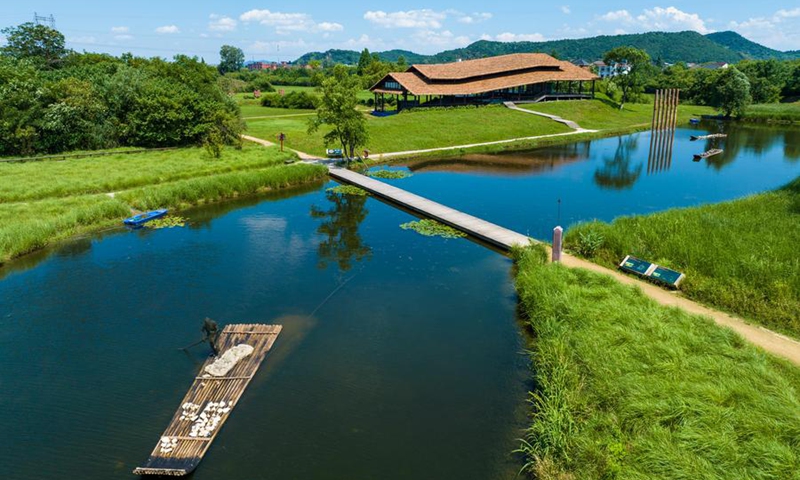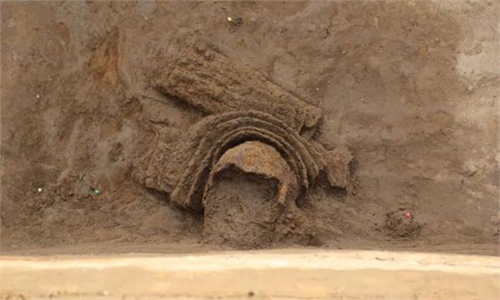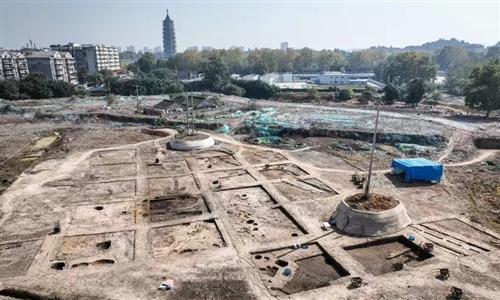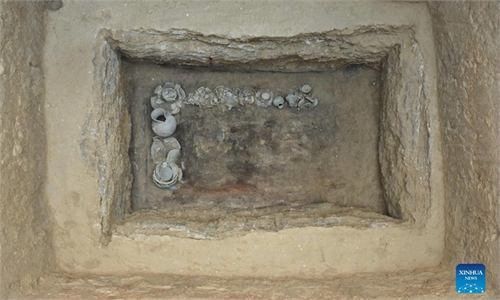ARTS / CULTURE & LEISURE
Liangzhu ancient city from over 4,300 years ago shows clear urban-rural divide

A drone photo taken on July 4, 2024 shows a display spot of Southern City Wall Site at the Archaeological Ruins of Liangzhu City park in Hangzhou, capital city of east China's Zhejiang Province. Photo: Xinhua
Archaeological findings suggest that Liangzhu ancient city, dating back 5,300 to 4,300 years ago, was a complex urban center with distinct urban-rural divide that heavily relied on "imported resources" such as grain and meat, experts revealed at a recent conference.
The Archaeological Ruins of Liangzhu City, located in today's Hangzhou, East China's Zhejiang Province, stand as an example of the more than 5,000 years of Chinese civilization. They were inscribed on the World Heritage List as a cultural site in 2019.
"Multidisciplinary research indicates that there were no rice fields within the perimeter of Liangzhu ancient city," said Wang Ningyuan, a researcher at the Zhejiang Provincial Institute of Cultural Relics and Archaeology.
According to Wang, archaeological findings show that, aside from the nobility and religious figures, the majority of the city's residents were skilled artisans involved in the production of jade, lacquerware, bone and horn tools, and stone implements. No evidence of farmers has been found.
"Liangzhu society exhibited a clear urban-rural division," Wang said. "The various resources and population of Liangzhu ancient city were all imported from outside, and its influence and level of development were beyond imagination."
According to Wang, archaeological discoveries in recent years reveal that the residents of Liangzhu ancient city came from various regions, and its resources also came from multiple areas.
The surrounding settlements had specialized division of labor, with some engaged in stone tool production and others in jade craftsmanship. The development of advanced rice agriculture promoted the social division of labor and the specialization of handicrafts, said Wang.
For example, a study of the grain storage pits at the Chizhongsi site revealed around 100,000 kilograms of carbonized rice grains. DNA analysis of the rice indicated that it came from at least six different regions, suggesting that the grains were imported from distant areas.
Furthermore, research on pig bones found at the site revealed that the animals likely originated from three separate regions, one of which was possibly as far away as Jiaxing, a neighboring city of Hangzhou.
Through analysis, it was also found that some individuals in the city had origins from the Central Plains and the Haidai region, reflecting the movement of people across cultural zones.
"These ongoing studies have deepened our understanding of the social diversity within Liangzhu," Wang told the Global Times on Sunday.
According to Wang, around 6,000 years ago, the process of social complexity accelerated in the lower reaches of the Yangtze River region, with the emergence of some central settlements, marking the first stage of the "ancient states era."
Around 5,300 years ago, with the rise of the Liangzhu civilization, the lower reaches of the Yangtze River region entered the second stage of the "ancient states era." The Liangzhu site represents this second phase of ancient kingdom development.
The rise of Liangzhu was deeply influenced by "geographic and climatic factors," noted Wang.
At that time, climate changes prompted the population in the lower reaches of the Yangtze River region to shift from a predominantly hunting-and-gathering economy with rice as a supplement, to a rice-centered agricultural model. The rapid sedimentation of the Yangtze River had largely formed the Taihu Plain, which, after long freshwater dilution, became a highly suitable area for rice cultivation. This transformation attracted a rapid influx of people from surrounding regions.
The Liangzhu site first came to light in 1936 when pieces of pottery and stone artifacts were discovered, followed by the discoveries of a significant number of tombs, altars and large-scale palace foundations in the 1980s and 1990s.
Currently, teams at the Liangzhu site have nearly completed archaeological surveys and detailed exploration. Over 20 new dams have been discovered, revealing the complete structure of the water management system, while the number of sites in the Liangzhu archaeological area has increased to more than 300.



